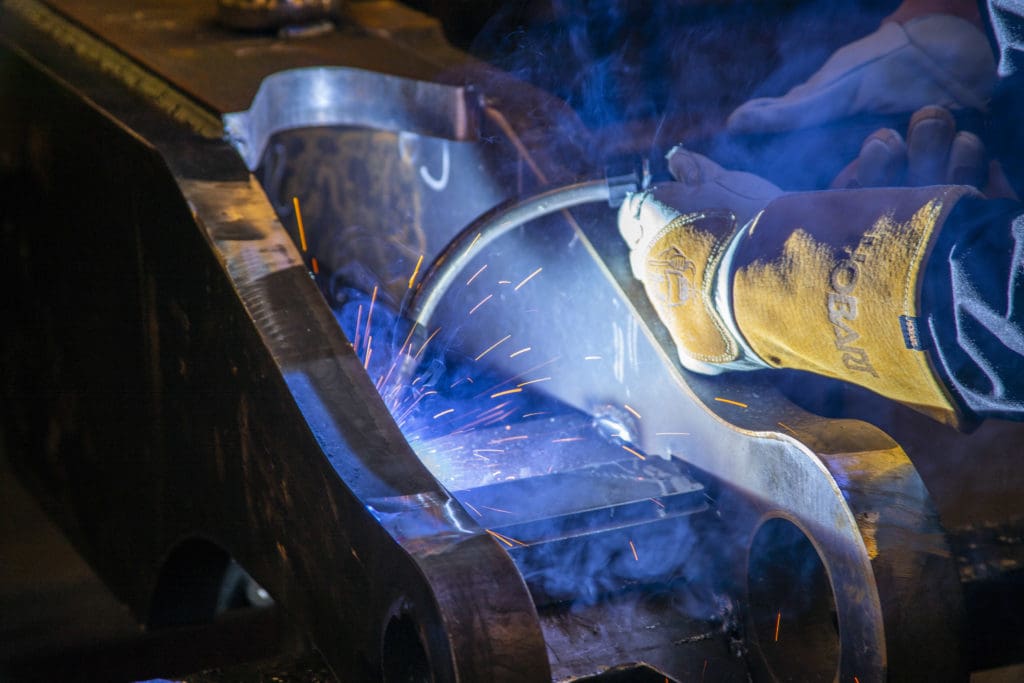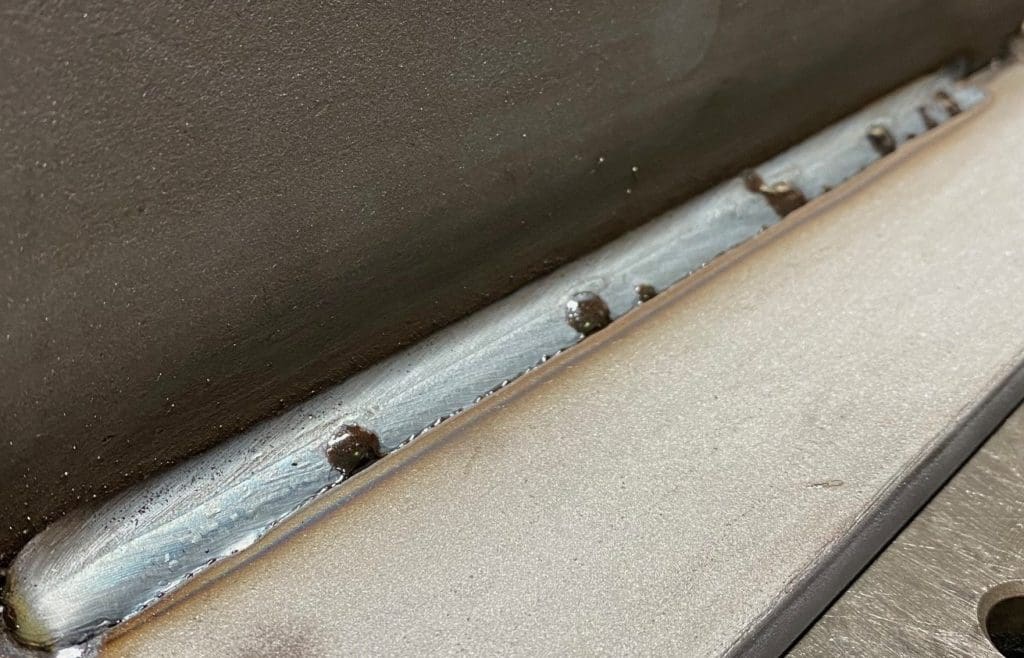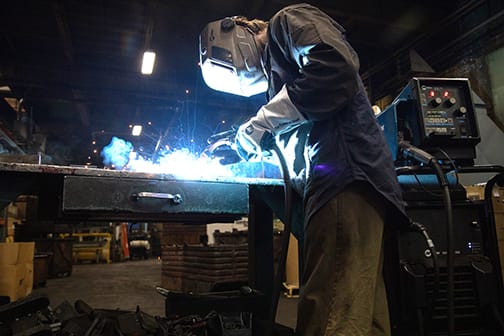Silicon Control Technology Helps Reduce Post-Weld Cleanup
Even though gas metal arc welding (GMAW) is generally considered to be a slag-free process, silicon islands present on the weld surface after welding are a normal (and largely unavoidable) byproduct of both solid and metal-cored wires. Unfortunately, they can be troublesome when it comes to post-weld cleanup. These islands are often small and hard to see, which can make it difficult to remove them completely.
Metal-cored wires designed with silicon control technology can help, saving time and improving productivity. These products can also save money — not just for labor, but also for the cost of wire wheel brushes and other tools used for cleaning up welds and removing silicon islands.

What are silicon islands?
Silicon is used in the steelmaking process as both a deoxidizer and an alloy to improve strength. For this reason, it is often present in both the base metal and the steel used to produce conventional welding wires — both solid and metal-cored. Metal-cored wires often have a slightly higher silicon content that helps make them more tolerant to welding through dirty surface conditions without creating porosity.
Silicon islands are caused by a chemical reaction similar to the reaction that occurs with fluxing agents. During this reaction, silicon in the weld bonds with impurities such as oxygen. This changes the density of the silicon, causing the silicate to float to the top of the weld pool and congregate into glassy island-like formations.
There are numerous factors that affect the quantity and size of silicon islands, including:
- Wire silicon content
- Base metal silicon content
- Presence of mill scale and other contaminants
- Welding parameters

Operators can exert some control over silicon levels by adjusting weld parameters. Using higher heat input — through a higher voltage and amperage — will melt more of the base metal, resulting in more silicon pickup and more silicon reaction in the weld pool. Using lower heat input typically results in lower silicon levels. Also, removing mill scale from the base metal before welding helps reduce silicon island formation significantly.
When do silicon islands become a problem?
There are many applications where the presence of silicon islands can cause problems that cost time and money.
- Post-weld painting: When finished components must be painted, silicon islands can be an issue. The islands can fall off after painting, exposing the bare metal underneath. This necessitates their complete removal.
- Multipass welds: Silicon islands can migrate into the weld toes during multipass welding. Depending on the parameters and technique of subsequent passes, they may not be liquefied by the arc or heat of the weld pool, leading to inclusions. These inclusions can form a stress riser that leads to cracking or early weld failure. Also, when silicon isn’t removed between passes it can accumulate. The islands will continue to grow in size and can eventually impede the welding arc or flow of the molten weld pool. If the operator welds over an especially large silicon island, the arc can become erratic because the silicon island is nonconductive. This could result in lack of fusion, poor penetration or inclusions.
Silicon control technology in metal-cored wires
Some metal-cored wires, such as the FabCOR® Edge™ XP wire from Hobart, feature “silicon control technology.” This technology uses small and carefully controlled element additions to influence silicon island size and distribution through changes to the surface tension and flow of the weld pool. As a result, the FabCOR Edge XP wire minimizes the positioning of silicon islands into the weld toes and minimizes overall distribution of silicon islands. This produces larger islands that float to the center of the weld so they are easier to see and remove.

Be aware that some of the elements most commonly used to influence the weld pool characteristic and silicon islands have relatively low melting points. In applications where joint restraint and solidification stresses are especially high, these elements may have a detrimental effect on solidification crack resistance. This can most often be mitigated by adhering to best practices regarding welding parameters and joint design, and managing thermally induced stresses. Most users, however, can convert to products containing silicon control technology with virtually no process changes.
Silicon control technology is a premium feature that is not included in all metal-cored wires, so it does impact the cost of the wire. Still, the benefits of reducing or eliminating silicon islands can help operations cut down on labor and rework, both of which are significantly higher drivers of overall weld cost.
Benefits of silicon control technology
Because FabCOR Edge XP produces larger silicon islands that are easier to see and remove, this wire boosts an operator’s confidence and productivity. They can be assured that they have completely removed the silicon islands — and reduced instances of rework.

Also, since the islands form toward the welding center line rather than sitting toward the weld toes, operators can complete post-weld cleaning with a variety of lighter-duty tools. A power wire wheel brush or a hand brush works well, and there will be less wear and tear on them. Silicon islands that are more entrenched at the toes require the use of more aggressive tools and techniques.
Reducing removal time and extending the life of grinding equipment results in cost savings for the operation.
Silicon control technology also tends to work best when the operator is producing good welds to start with. If the weld bead is very convex and not smooth, silicon problems can be amplified. FabCOR Edge XP wire helps the operator produce very good weld bead appearance and contour, which then helps the technology do its job. Potential users should be aware that flat and smooth welds generally require less post-weld cleanup and rework.
When should silicon control technology be used?
Silicon control technology should be employed when production efficiency is a concern. The technology helps the welder spend more time welding and less time cleaning welds.
However, silicon control technology is not 100% effective in all applications. Some silicon may still form in small islands and/or into the weld toes, but most users will notice an improvement in overall silicon distribution and average weld cleaning time.

While wires with silicon control technology can provide optimal performance when welding over blasted/ground base metal or light unremoved mill scale and contaminants, they may lose some effectiveness when the mill scale is very heavy (a common occurrence on very thick base metals). Once mill scale gets to a certain thickness, it becomes harder for the silicon control technology to work as intended. In these cases, spending time on pre-weld cleanup can sometimes save time overall by improving the performance of the wire from the perspective of both silicon control and ease of making high-quality welds.



